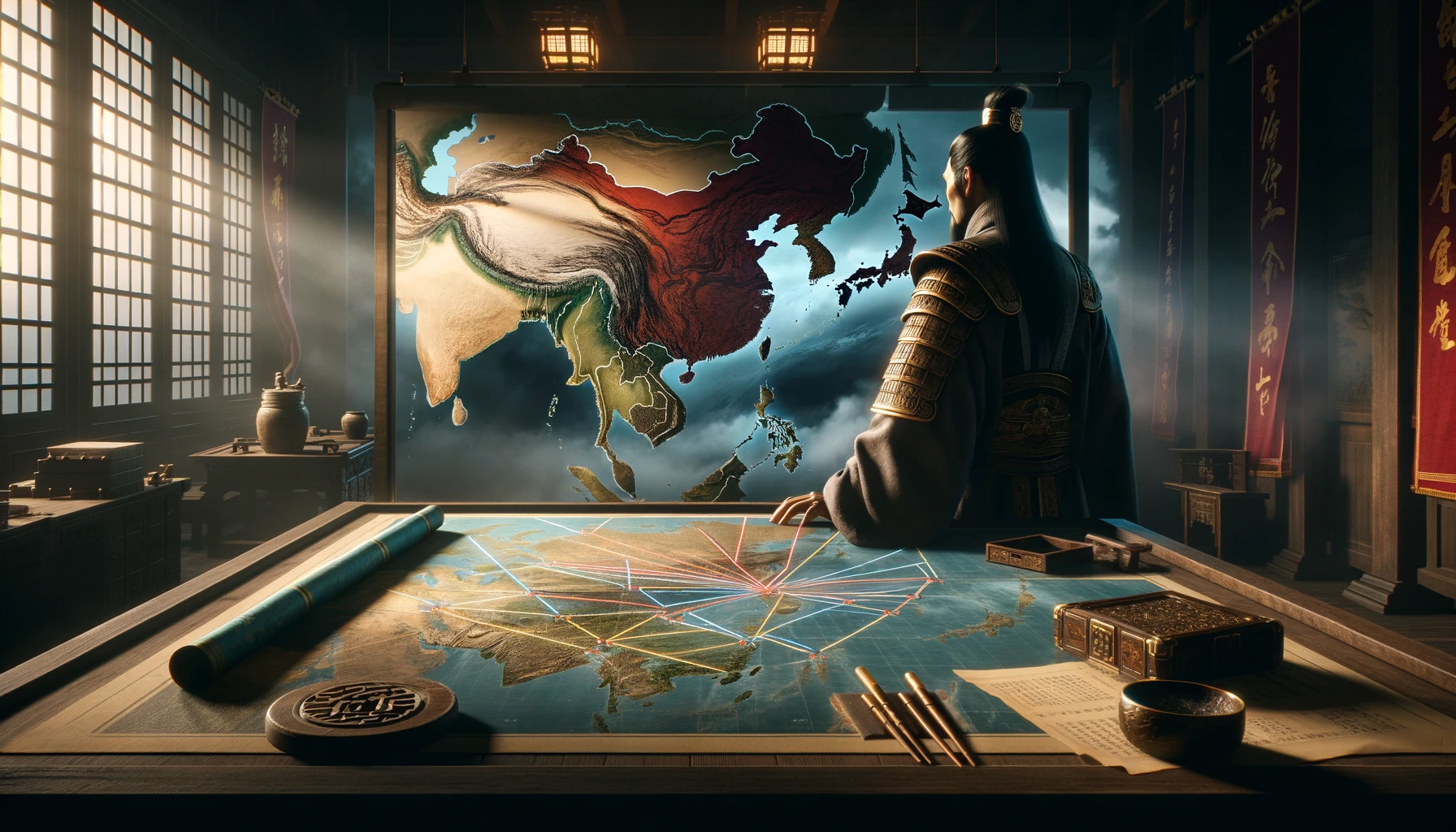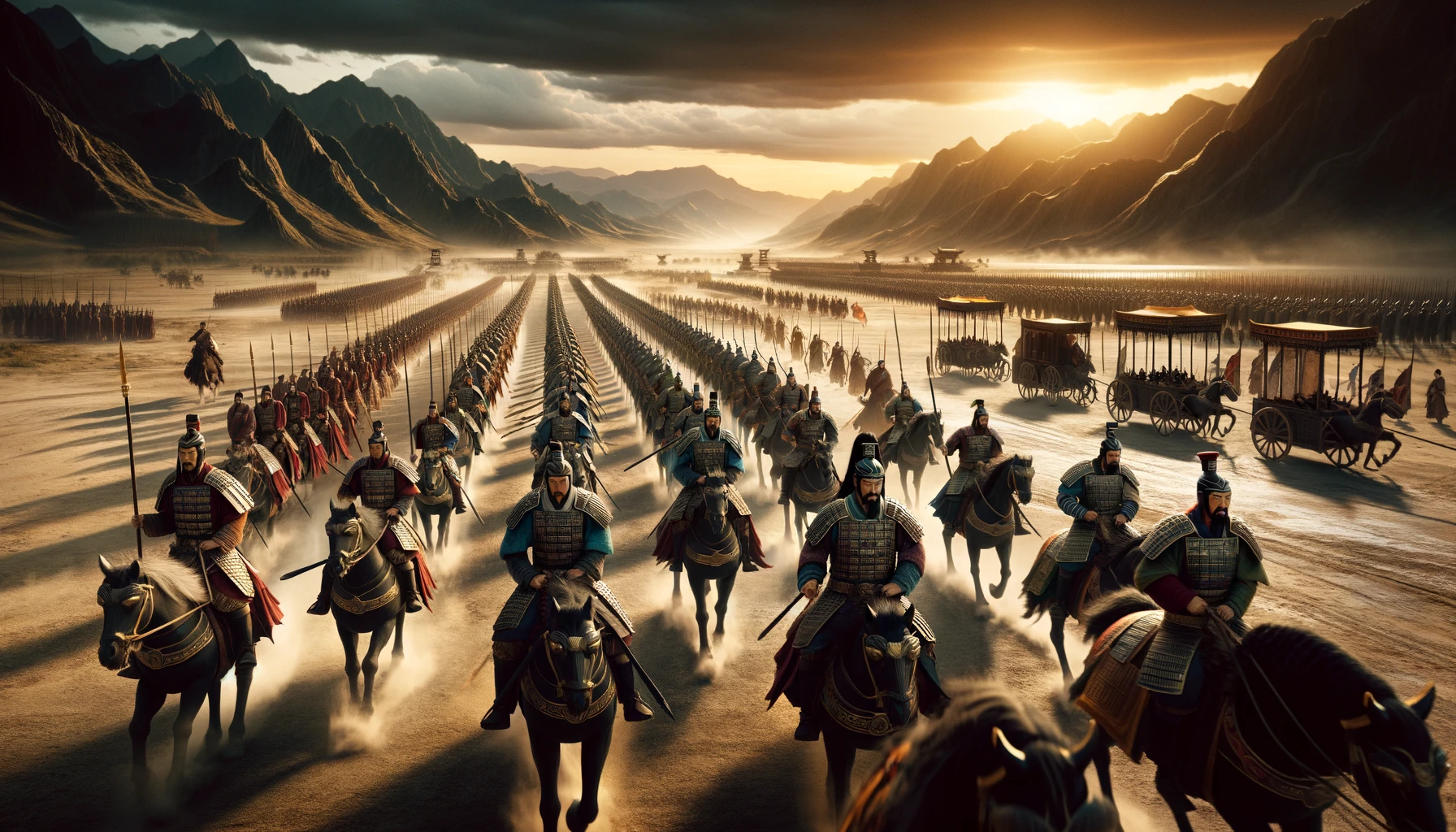The Qin Dynasty (221 – 206 BCE) marked a pivotal period in ancient Chinese history, renowned for its unification of the country and establishment of the first imperial dynasty. This era witnessed remarkable achievements, including the construction of the Great Wall of China and the creation of the awe-inspiring Terracotta Army.
Key Takeaways:
- The Qin Dynasty ended the Warring States Period and unified China under a centralized government.
- Major projects like the Great Wall and Terracotta Army exemplified the dynasty’s engineering prowess.
- Qin Shi Huang introduced far-reaching reforms based on the Legalist philosophy, impacting governance, economics, and society.
- The Qin Dynasty laid the foundation for subsequent imperial dynasties and left a lasting legacy on Chinese culture.
The Rise of the Qin Dynasty and its Unification of China

The Qin Dynasty emerged from the chaos of the Warring States Period, a turbulent era marked by constant conflicts between various Chinese states. Under the leadership of Qin Shi Huang, the first emperor of the Qin Dynasty, these warring states were gradually conquered and unified into a single, centralized empire.
This unification was a monumental achievement, ending centuries of political fragmentation and ushering in a new era of stability and imperial rule. Qin Shi Huang’s Legalist philosophy), emphasizing strict adherence to laws and absolute obedience to the ruler, played a crucial role in consolidating his power and maintaining control over the vast territory.
“The law must be enforced with the utmost severity, for it is the root of order and stability.” – Qin Shi Huang
To further strengthen his grip on the empire, Qin Shi Huang implemented a series of far-reaching reforms. These reforms aimed to standardize various aspects of life, including:
- Economic standardization: Uniform weights, measures, and currency were introduced throughout the empire, facilitating trade and taxation.
- Administrative centralization: A hierarchical and efficient bureaucracy was established, with the emperor at the apex and local officials appointed to govern territories.
- Emphasis on agricultural production: Policies were enacted to promote agriculture, ensuring a steady food supply and supporting the growing population.
Major Projects and Engineering Marvels of the Qin Dynasty

One of the most remarkable achievements of the Qin Dynasty was the construction of the Great Wall of China. Originally built to protect the empire from nomadic invasions, the Great Wall represents an extraordinary feat of engineering and human labor. It stretched for thousands of kilometers, winding across treacherous terrain and serving as a formidable defensive barrier.
Another engineering marvel of the Qin Dynasty was the creation of the Terracotta Army. This awe-inspiring collection of life-sized terracotta warriors and horses was buried alongside Qin Shi Huang’s mausoleum, intended to protect him in the afterlife. Discovered in 1974, the Terracotta Army is a testament to the dynasty’s artistic and technological achievements.
| Project | Description |
|---|---|
| Great Wall of China | A vast defensive fortification stretching thousands of kilometers across northern China. |
| Terracotta Army | A collection of life-sized terracotta warriors and horses guarding Qin Shi Huang’s mausoleum. |
| Epang Palace | The imperial palace and administrative center of the Qin Dynasty, located in modern-day Xi’an. |
| Lingqu Canal | An artificial waterway connecting the Xiang and Li rivers, facilitating transportation and irrigation. |
“The Qin Dynasty left an indelible mark on Chinese history, exemplified by its monumental engineering projects and lasting cultural impact.” – Historian John Keay
the key things the Qin Dynasty did to unify China:

1. Military Campaigns and Conquest:
- Qin Shi Huang, the first emperor of the Qin Dynasty, led a series of military campaigns to conquer the various warring states and bring them under his control.
- These military conquests eliminated the rival states and consolidated Qin’s power over a vast territory, paving the way for unification.
2. Centralized Government and Administration:
- The Qin Dynasty established a highly centralized and efficient bureaucratic system, with the emperor at the apex.
- Local officials were appointed by the central government to govern territories, ensuring strict control and adherence to imperial policies.
3. Standardization of Laws, Currency, and Measurements:
- The Qin Dynasty implemented standardized legal codes, weights, measures, and a uniform currency system across the empire.
- This facilitated governance, trade, taxation, and the integration of the diverse regions under Qin rule.
4. Infrastructure Development:
- Major infrastructure projects, such as the construction of the Great Wall of China, road networks, and irrigation systems, helped connect and fortify the unified territory.
- These projects also demonstrated the dynasty’s engineering prowess and ability to mobilize vast resources.
5. Cultural and Ideological Unification:
- The Qin Dynasty promoted the Legalist philosophy, emphasizing strict adherence to laws and absolute obedience to the ruler.
- This ideology helped solidify the central authority and maintain control over the unified empire.
The man primarily responsible for unifying China under the Qin Dynasty was Qin Shi Huang, also known as the First Emperor of Qin. He succeeded in bringing the warring states under a single, centralized empire through his military conquests, administrative reforms, and implementation of standardized systems.
Conclusion

The Qin Dynasty, though short-lived, played a pivotal role in shaping ancient Chinese history. Its unification of the country, implementation of Legalist reforms, and construction of engineering marvels like the Great Wall and Terracotta Army cemented its legacy as a transformative era. The dynasty’s centralized governance and emphasis on standardization laid the foundation for subsequent imperial dynasties, influencing Chinese culture and society for centuries to come.
FAQ
Q: What led to the fall of the Qin Dynasty? A: The Qin Dynasty’s harsh laws, oppressive rule, and the burden of extensive construction projects led to widespread unrest and uprisings. Additionally, the death of Qin Shi Huang and a succession crisis further destabilized the empire, eventually leading to its collapse in 206 BCE.
Q: How did the Legalist philosophy impact the Qin Dynasty? A: The Legalist philosophy, which emphasized strict adherence to laws and absolute obedience to the ruler, was a guiding principle for the Qin Dynasty. It played a crucial role in consolidating power, maintaining control over the vast territory, and implementing far-reaching reforms in governance, economics, and society.
Q: What was the significance of the Terracotta Army? A: The Terracotta Army, a collection of life-sized terracotta warriors and horses, was a remarkable archaeological discovery that shed light on the Qin Dynasty’s artistic and technological achievements. It was buried alongside Qin Shi Huang’s mausoleum and intended to protect him in the afterlife, showcasing the dynasty’s belief systems and artistic expression.

